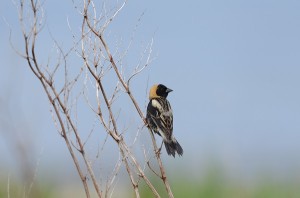Perhaps you have noticed that birdsong has been a little insipid this spring. The woods have been quieter than usual because the birds are late arriving. I am still waiting for a host of species to show up in my yard, including such staples as Great Crested Flycatcher, Red-eyed Vireo, and Veery. Of the migrants that are here already, almost all are behind schedule.
In an excellent piece of statistical analysis, Pam Hunt of New Hampshire Audubon calculated the median arrival date for New Hampshire’s migrant birds using forty years of data beginning in the 1960’s (NH Bird Records, Volume 26, No. 1). A median is the midpoint in a dataset. Half the data is of a higher value than the median and half is of a lower value. Based on her analysis, the median date for Wood Thrush is May 7th. This means that since the 1960’s, half of the first Wood Thrush reports have been on or before May 7th. This year I first heard my first Wood Thrush on May 11, four days later than the median, and more than a month later than the earliest recorded date of April 4th. The pattern continues as follows (median date in parentheses); Ruby-throated Hummingbird May 15, (May 5); Yellow-rumped Warbler, April 19 (April 13); Black-throated Green Warbler, May 1 (April 29); Scarlet Tanager, May 11 (May 7).
The reason for all these Johnny-come-lately birds is reflected in the curious title, a phrase which has lit up the blogosphere recently. For two weeks beginning in late April, a large high pressure system developed over New England. In addition to creating the beautiful weather we enjoyed in early May, the high pressure effectively blocked the normal progression of cyclonic systems that is responsible for creating the southerly winds beloved by spring migrants. These “blocking” highs come in a variety of barometric patterns. An Omega Block is created by a low-high-low pressure arrangement, the airflow around which follows a pattern reminiscent of the upper case Greek letter Omega. This system didn’t break until May 9th, and right on cue a number of laggard species showed up in the ensuing days – clear evidence if any was needed, of the role that weather plays in bird migration. You can read more about this phenomenon on my website ericmasterson.com
Between the Omega Block and the lack of any period of sustained southerlies and frontal systems to bring birds into the region, it has been a remarkably poor spring for birding, though there are still two weeks to go before it’s over. As always at this time of year, Star Island is one of the best places to witness migration, and I will be leading the second of two trips to the island on May 25th. Enquire at eric.masterson@myfairpoint.net for more information.

No comments yet.